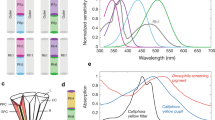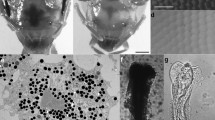Summary
Thanks to a technique of optical neutralisation associated with a transilluinination of the eye, it is possible to study the photoreceptor endings (rhabdomere tips) in the compound eye of live and intact Drosophilae.
The success of the neutralisation process directly confirms the idea that the convergence of the dioptric system in each ommatidium is essentially due to the refraction at the corneal outer surface. The remarkable regularity of the asymmetrical receptor pattern throughout the eye (fig. 7) is of functional importance. The divergence angle between the optical axis of neighbouring receptors, and their farfield radiation pattern are shown to depend respectively on the spacing and the diameter of the rhabdomere distal endings (fig. 8). The tip of the centrally located rhabdomere number 7 (fig. 5) is found to have a smaller optical diameter than its six neighbours and the extinction spectrum of this rhabdomere is different from those of the other ones. Modal patterns are observed at the distal tip of the rhabdomeres (fig. 9), confirming the waveguide properties of these components. The eye of Drosophila is morphologically composed of two equal parts, dorsal and ventral, in which the rhabdomere patterns are symmetrical (fig. 7). Sporadic irregularities are found in the border between these two parts (fig. 10).
Actually the main importance of this neutralisation technique lies in its possible applications. The simultaneous visualization of a lot of receptors, in transmitted light, allows a precise stimulation, in incident light, of single and known cells in the eye of live insects. This method combined with other in vivo techniques such as those using the phenomenons of “corneal pseudopupil” (Kirschfeld and Franceschini, 1968) and “deep pseudopupil” (Franceschini and Kirschfeld, 1971a) may simplify further studies regarding the nervous integration of visual stimuli in the facet eye.
Similar content being viewed by others
Références
Autrum H. J., Wiedemann I.: Versucheüber den Strahlengang im Insektenauge (Appositionsauge). Z. Naturforsch. 17b, 480–482 (1962).
Becker H. J.: Zur Entwicklungsphysiologie des Drosophila-Auges. Verh. Dtsch. Zool. Ges. in Hamburg, 1956.
Bernhard C. G., Miller W. H., Møller A. R.: The insect corneal nipple array. Acta physiol. scand. 63, Suppl. 243 (1965).
Braitenberg V.: Patterns of projection in the visual system of the fly. I. Retina-Lamina projections. Exp. Brain Res. 3, 271–298 (1967).
Brindley G.S., Rushton W. A. H.: The colour of monochromatic light when passed into the human retina from behind. J. Physiol. (Lond.) 147, 204–208 (1959).
Carricaburu P.: Contribution à la dioptrique oculaire des arthropodes: détermination des indices des milieux transparents de l'ommatidie. Thèse, Soc. d'hist. Natur, de l'Afrique du Nord (Alger), Mém. 9, nouvelle Série (1968).
Danneel R., Zeutzschel B.: Über den Feinbau der Retinula bei Drosophila Melanogaster. Z. Naturforsch. 12b, 580–583 (1957).
Dietrich W.: Die Facettenaugen der Dipteren. Z. wiss. Zool. 92, 465–539 (1909).
Drabowitch S.: Application aux antennes de la théorie du signal. L'Onde Electrique 458, 550–560 (1965).
Enoch J. M.: Visualization of wave-guide modes in retinal receptors. Amer. J. Ophtal. 51, 1107–1118 (1961).
—: Comments on: Excitation of waveguide modes in retinal receptors. J. opt. Soc. Amer. 57, 548–549 (1967).
Exner, S.: Die Physiologie der fazettierten Augen von Krebsen und Insekten. Leipzig u. Wien: Deutike 1891.
Franceschini.N.: Le traitement optique de l'information visuelle dans l'œil composé de la Drosophile. Thèse (C.N.R.S. No. AO3802, Paris) (1971).
Franceschini.N., Kirschfeld K.: Les phénomènes de pseudopupille dans l'œil composé de Drosophila. En préparation (1971 a).
Franceschini.N., Kirschfeld K.: An automatic gain control in the photoreceptors of Drosophila,. Kybernetik, en préparation (1971b).
Gemperlein R., Järvilehto M.: Direkte Beobachtung der Rhabdomere bei Calliphora erythrocephala (Meig.). Z. vergl. Physiol. 65, 445–454 (1966).
Götz K. G.: Optomotorische Untersuchung des visuellen Systems einiger Augenmutanten der Fruchtfliege Drosophila. Kybernetik 2, 77–92 (1964).
—: Die optischen Übertragungseigenschaften der Komplexaugen von Drosophila. Kybernetik 2, 215–221 (1965).
Homann H.: Der Vertikalluminator als Augenspiegel bei kleinen Augen. Biol. Zbl. 44, 582–592 (1924).
Johannsen O.A.: Eye structure in normal and eye-mutant drosophilas. J. Morph. Physiol. 39, 337–349 (1924).
Kapany N. S.: Fiber optics. New York-London: Academic Press 1967.
Kiesel A.: Untersuchungen zur Physiologie des facettierten Auges. S.-B. Akad. Wiss. Wien, math.-nat. Kl. 103, 97–139 (1894).
Kirschfeld K.: Die Projektion der optischen Umwelt auf das Raster der Rhabdomere im Komplexauge von Musca. Exp. Brain Res. 3, 248–270 (1967).
—: Absorption properties of photopigments in single rods, cones and rhabdomeres. dans: Rendiconti della S.I.F. E. Fermi (XLIII Corso). Processing of optical information in the animals and machines. London-New York: Academic Press 1969.
—, Franceschini N.: Optische Eigenschaften der Ommatidien im Komplexauge von Musca. Kybernetik 5, 47–57 (1968).
—: Ein Mechanismus zur Steuerung des Lichtflusses in den Rhabdomeren des Komplexauges von Musca. Kybernetik 6, 13–22 (1969).
—, Reichardt W.: Die Verarbeitung stationärer Nachrichten im Komplexauge von Limulus. Kybernetik 2, 43–61 (1964)
Kuiper J. W.: The optics of the compound eye. Symp. Soc. exp. Biol. 16, 58–71 (1962).
—: On the image formation in a single ommatidium of the compound eye in diptera. In: The functional organization of the compound eye (C. G. Bernhard, ed.). Oxford: Pergamon Press 1966.
Kunze P.: Die Orientierung der Retinulazellen im Auge von Ocypode. Z. Zellforsch. 90, 454–462 (1968).
Langer H.: Spektrometrische Untersuchungen der Absorptionseigenschaften einzelner Rhabdomere im Facettenauge. Verh. Dtsch. Zool. Ges. in Jena (1965).
—, Thorell B.: Microspectrophotometric assay of visual pigment in single rhabdomeres of the insect eye. In: The functional organization of the compound eye (C. G. Bernhard, ed.). Oxford: Pergamon Press 1966.
Le Grand Y.: Optique physiologique, Tome I.: La dioptrique de l'œil et sa correction. Ed. de la Revue d'optique, Paris 1964.
Marks W. B.: Visual pigments of single goldfish cones. J. Physiol. (Lond.) 178, 14–32 (1965).
Nolte D. J.: Submicroscopic structure of the Drosophilid eye. S. Afr. J. Sci. 57, 121–125 (1961).
Ratliff F., Hartline H. K., Lange D.: The dynamics of lateral inhibition in the compound eye I. In: The functional organization of the compound eye (C. G. Bernhard, ed.) Oxford: Pergamon Press 1966.
Schneider L., Langer H.: Die Feinstruktur des Überganges zwischen Kristallkegel und Rhabdomeren im Facettenaugc von Calliphora. Z. Naturforsch. 21b, 196–197 (1966).
Schouten J. F.: Eine entoptische Methode zur Bestimmung der spektralen Durchlässigkeit der Augapfelwand. Proc. Acad. Sci. (Amst.) 37, 516–520 (1934).
Seitz.G.: Der Strahlengang im Appositionsauge von Calliphora erythrocepha (Meig.). Z. vergl. Physiol. 59, 205–231 (1968).
Stockhammer K.: Zur Wahrnehmung der Schwingungsrichtung linear polarisiertes Licht bei Insekten. Z. vergl. Physiol. 38, 30–83 (1956).
Toruita T., Kaneko A., Murakami M., Pautler E. L.: Spectral response curves of single cones in the carp. Vision Res. 7, 519–531 (1967).
Trujillo-Cenoz O., Melamed J.: Electron microscope observations on the peripheral and intermediate retinas of dipterans. In: The functional organization of the compound eye (C. G. Bernhard, ed.). Oxford: Pergamon Press 1966.
Varela F. G., Wiitanen W.: The optics of the compound eye of the honeybee (Apis Mellifera). J. gen. Physiol. 55, 336–358 (1970).
Vigier P.: Sur les terminaisons photoréceptrices dans les yeux composés des Muscidés. C. R. Acad. Sci. (Paris) 145, 532–536 (1907a).
—: Sur la réception de l'excitant lumineux dans les yeux composés des insectes, en particulier chez les Muscidés. C. R. Acad. Sci. (Paris) 145, 633–636 (1907 b).
Waddington C. H., Perry M. M.: The ultrastructure of the developing eye of Drosophila. Proc. roy. Soc. B 153, 155–178 (1960).
Wolken J. J., Mellon A. D., Contis G.: Photoreceptor structures. II. Drosophila Melanogaster. J. exp. Zool. 134, 383–409 (1957).
Yasuzumi G., Deguchi N.: Submicroscopic structure of the compound eye as revealed by electron microscopy. J. Ultrastruct. Res. 1, 259–270 (1958).
Author information
Authors and Affiliations
Additional information
Partie d'une thèse de Doctorat d'Etat es Sciences Physiques de l'Université de Grenoble (1971), enregistrée au C.N.R.S. (Paris) sous le No A.O. 3802.
Nos plus vifs remerciements vont à Mr. K. G. Götz pour son apport personnel lors des expériences et de l'interprétation des résultats, de même qu'à Mr. W. Reichardt pour de fructueuses discussions et à Mr. Y. Le Grand pour la critique du manuscript. Nous remercions aussi Melles T. Wiegand et B. Koehler pour leur collaboration technique, ainsi que Mr. E. Freiberg pour la finition des dessins. N. F. tient à exprimer sa reconnaissance au Deutscher Akademischer Austauschdienst et à la Max-Planck-Gesellschaft, qui ont successivement financé son séjour à l'Institut Max-Planck de Cybernétique biologique.
Rights and permissions
About this article
Cite this article
Franceschini, N., Kirschfeld, K. Etude optique in vivo des éléments photorécepteurs dans l'œil composé de Drosophila . Kybernetik 8, 1–13 (1971). https://doi.org/10.1007/BF00270828
Accepted:
Issue Date:
DOI: https://doi.org/10.1007/BF00270828




